Transform Your Space: Master the Art of Track Lighting Layout Like a Pro!
Track lighting is a versatile and stylish option that can dramatically enhance the atmosphere of any room. Whether you are aiming to illuminate a cozy reading nook, highlight artwork, or simply brighten up a kitchen, track lighting offers both functionality and aesthetic appeal. A well-planned track lighting layout can transform your space, making it not only visually striking but also practical for your daily activities. In this guide, we will take you through a step-by-step process to effectively plan your track lighting layout, ensuring that you achieve the perfect balance of light and design in your home.

Understanding Track Lighting Basics
Before diving into the planning process, it’s essential to understand what track lighting is and the various types available. Track lighting consists of a series of light fixtures mounted on a track, allowing you to direct light where it’s needed most. There are two primary types of track lighting: monorail and standard track systems. Monorail systems offer a more decorative and flexible approach, while standard track systems provide a straightforward installation with a more utilitarian look. Key components of a track lighting system include the track itself, the fixtures, and the bulbs used. Familiarizing yourself with these basics will lay a strong foundation for planning your track lighting layout effectively.
Step 1: Assessing Your Space
To start planning your track lighting layout, you first need to assess the space where the lighting will be installed. Measure the dimensions of the room, taking note of the ceiling height and any architectural features such as beams, windows, or built-in shelves. Consider how these elements may affect your lighting design. Additionally, identify areas that require illumination, such as workspaces, artwork, or darker corners of the room. A friend of mine recently renovated her living room and found that measuring the space helped her visualize how the track lighting would complement her new décor.
Step 2: Defining Your Lighting Needs
Once you have a clear understanding of your space, the next step is to define your lighting needs. Consider the purpose of the lighting: is it for ambient lighting to create a warm atmosphere, task lighting for specific activities like reading or cooking, or accent lighting to highlight certain features? Prioritize areas based on their specific needs. For instance, if you’re designing a home office, you may want brighter task lighting over your desk while using softer ambient lighting for the rest of the room. This tailored approach ensures that every corner of your space serves its intended function while enhancing the overall aesthetic.
Step 3: Choosing the Right Track Lighting System
With a clear understanding of your space and lighting needs, it’s time to choose the right track lighting system. Consider the length of the track you will require based on your room's dimensions and layout. Additionally, think about the type of fixtures that will best suit your style and functional needs. Some fixtures are adjustable, allowing you to direct light precisely where you need it, while others provide fixed lighting angles. Don't forget to explore bulb options as well; LED bulbs are energy-efficient and come in a variety of color temperatures to create the desired ambiance. My neighbor opted for adjustable fixtures in her kitchen, which allowed her to focus light on the countertops while illuminating the entire room beautifully.
Step 4: Planning the Layout
Now that you have your system chosen, it’s time to plan the layout. Begin by sketching a rough diagram of the room, marking where the track will be installed. Consider spacing the fixtures evenly along the track for balanced light distribution, taking care to angle them toward focal points or areas that need more illumination. Avoid placing fixtures too close to walls to prevent shadows and glare. A good rule of thumb is to keep about 6 to 8 feet between fixtures, depending on the brightness you desire. This step can be quite creative, as you can visualize how different angles and placements will impact the overall lighting effect. A friend of mine shared how adjusting the angles of her fixtures transformed the mood of her dining area, making it feel more welcoming during dinner parties.
Step 5: Installation Tips and Considerations
Finally, let’s discuss installation. While some may choose to tackle this project themselves, it’s crucial to prioritize safety. Ensure you have all necessary tools, such as a drill, level, and wire strippers. When installing, always turn off the power to avoid any electrical hazards. If you’re uncertain about any part of the installation process, don’t hesitate to consult a professional electrician. They can provide expert advice and ensure your track lighting system is installed safely and efficiently. A family member of mine learned the hard way about the importance of hiring a professional; they ended up with flickering lights and had to redo the installation!
Effective Track Lighting Planning Summary
In conclusion, planning a track lighting layout requires careful consideration and creativity, but the results can be incredibly rewarding. By assessing your space, defining your lighting needs, choosing the right system, planning a thoughtful layout, and following safe installation practices, you can transform your home with beautiful and functional track lighting. Take your time with each step, experiment with different configurations, and enjoy the process of enhancing your space. With the right planning, your track lighting can illuminate your home beautifully, making it a cozy and inviting place to be.








